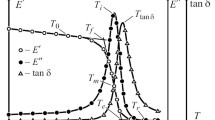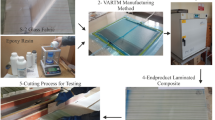Abstract
Under extreme services conditions, the dynamic mechanical properties of polymer matrix composites play an important role in controlling the durability of composite structures. Temperature–frequency-dependent dynamic mechanical properties of glass/epoxy composites were studied under different loading modes by dynamic mechanical analysis. The temperature-dependent modulus and temperature–frequency-dependent modulus models of epoxy resin and glass/epoxy composites were developed. The physical meaning and how to determine the values of parameters in the model were discussed. All the model predictions showed good agreements with the experimental results.











Similar content being viewed by others
References
Odegard G, Kumosa M (2000) Elastic-plastic and failure properties of a unidirectional carbon/PMR-15 composite at room and elevated temperatures. Compos Sci Technol 60(16):2979–2988
Havriliak S, Negami S (1966) A complex plane analysis of α-dispersions in some polymer systems. J Polym Sci Part C 14:99–117
Szabo JP, Keough IA (2002) Method for analysis of dynamic mechanical thermal analysis data using the Havriliak-Negami model. Thermochim Acta 392–393:1–12
Setua DK, Gupta YN, Kumar S, Awasthi R, Mall A, Sekhar K (2006) Determination of dynamic mechanical properties of engineering thermoplastics at wide frequency range using Havriliak-Negami model. J Appl Polym Sci 100:677–683
Bai Y, Keller T, Vallee T (2008) Modeling of stiffness of FRP composites under elevated and high temperatures. Compos Sci Technol 68(15–16):3099–3106
Bai Y, Keller T (2014) High temperature performance of polymer composites. Wiley, Weinheim
Mahieux CA, Reifsnider KL (2009) Property modeling across transition temperatures in polymers: a robust stiffness temperature model. Polymer 42(7):3281–3291
Reifsnider KL, Mahieux CA (2002) Property modeling across transition temperatures in polymers: application to filled and unfilled polybutadiene. J Elastom Plast 34(1):79–89
Gibson AG, Browne TNA, Feih S, Mouritz AP (2012) Modeling composite high temperature behavior and fire response under load. J Compos Mater 46(16):2005–2022
Kandare E, Kandola BK, Myler P, Horrocks AR, Edwards G (2010) Thermo-mechanical responses of fibre reinforced epoxy composites exposed to high temperature environments: I : Experimental data acquisition. J Compos Mater 44:3093–3114
Kandare E, Kandola BK, McCarthy ED, Myler P, Edwards G, Jifeng Y, Wang YC (2011) Fiber-reinforced epoxy composites exposed to high temperature environments. Part II: modeling mechanical property degradation. J Compos Mater 45:1511–1521
Nam JD (1991) Polymer matrix degradation: characterization and manufacturing process for high temperature composites. PhD dissertation, University of Washington
Guo ZS, Feng JM, Wang H, Hu HJ, Zhang JQ (2013) A new temperature-dependent modulus model of glass/epoxy composite at elevated temperatures. J Compos Mater 47(26):3303–3310
Feng J, Guo ZS (2015) Temperature-frequency-dependent dynamic mechanical properties of epoxy resin and its composites. Compos Part B. doi:10.1016/j.compositesb.2015.09.040
Fuoss RM, Kirkwood JG (1941) Electrical properties of solids. VIII. Dipole moments in polyvinyl chloride-diphenyl systems. J Am Chem Soc 63(2):385–394
Sanchis MJ, Diaz-Calleja R, Pelissou O, Gargallo L, Radic D (2004) Dynamic mechanical and dielectric relaxations in poly (di-n-chloroalkylitaconates). Polymer 45(6):1845–1855
Faguaga E, Perez CJ, Villarreal N, Rodriguez ES, Alvarez V (2012) Effect of water absorption on the dynamic mechanical properties of composites used for windmill blades. Mater Des 36:609–616
ASTM E1640-13. Standard test method for assignment of the glass transition temperature by dynamic mechanical analysis
Gabbott P (2008) Principles and applications of thermal analysis, vol 1. Blackwell Publishing Ltd, Oxford, p 26
Akay M (1993) Aspects of dynamic mechanical analysis in polymer composites. Compos Sci Technol 47(4):419–423
Tsang CF, Hui HK (2001) Multiplexing frequency mode study of packaging epoxy molding compounds using dynamic mechanical analysis. Thermochim Acta 367–368(8):93–99
Zhang QH, Luo WQ, Gao LX, Chen DJ, Ding MX (2004) Thermal mechanical and dynamic mechanical property of biphenyl polyimide fibers. J Appl Polym Sci 92:1653–1657
Devi LU, Bhagawan SS, Thomas S (2011) Dynamic mechanical properties of pineapple leaf fiber polyester composites. Polym Compos 32:1741–1750
Walker RA, Karbhari VM (2007) Durability based design of FRP jackets for seismic retrofit. Compos Struct 80(4):553–568
Nguyena TC, Bai Y, Zhao XL, Mahaidi RA (2012) Durability of steel/CFRP double strap joints exposed to sea water, cyclic temperature and humidity. Compos Struct 94(5):1834–1845
Ward IM (1971) Mechanical properties of solid polymers, vol 5. Wiley, London
Acknowledgements
The authors would like to acknowledge NSFC for financial support (10702036, 11472165).
Author information
Authors and Affiliations
Corresponding author
Rights and permissions
About this article
Cite this article
Feng, J., Guo, Z. Effects of temperature and frequency on dynamic mechanical properties of glass/epoxy composites. J Mater Sci 51, 2747–2758 (2016). https://doi.org/10.1007/s10853-015-9589-5
Received:
Accepted:
Published:
Issue Date:
DOI: https://doi.org/10.1007/s10853-015-9589-5




